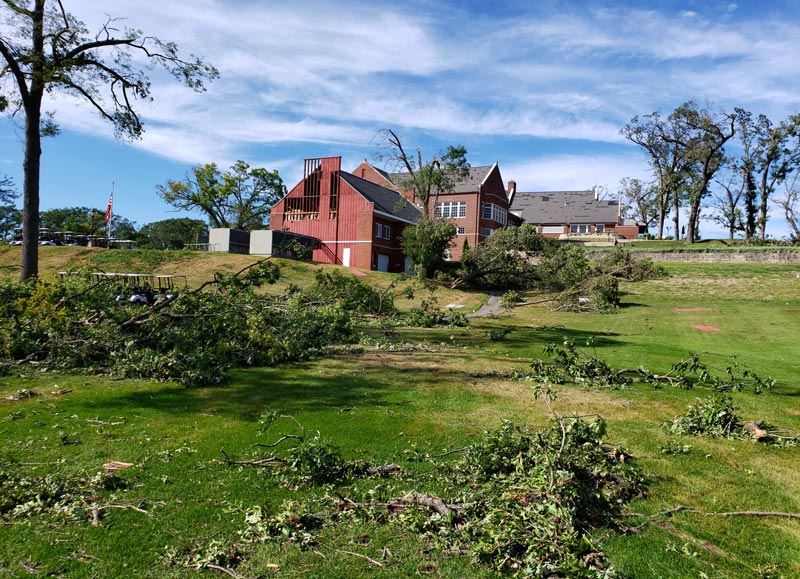
Derecho destruction at Cedar Rapids (Iowa) Country Club included damage to the facility’s golf studio/bag room and the loss of 800 trees. The National Weather Service estimates wind speeds in Cedar Rapids reached 140 mph. Photo courtesy of Tom Feller
When David Eichhorn laid eyes on the carnage sprawled across Elmwood Country Club from the storm that ripped through the Midwest on Monday, Aug. 10, the emotions came in waves.
“When I first came out to look, it was just utter shock,” says Eichhorn, who is in his first year as superintendent at the 18-hole course in Marshalltown, Iowa. “I didn’t realize how bad it was. I was just going through the stages of shock. Then it was almost humorous. What in the heck just happened? I didn’t know how to react. I kind of sat on it, and the next day got out to survey the damage. It was just this overwhelming feeling of, ‘This is a bad deal.’ That storm had so much power; it’s hard to wrap your head around it.”
More than a week later, it hasn’t gotten any easier.
Meteorologists say the devastating storm — a derecho, which the National Weather Service defines as a fast-moving but “widespread, long-lived wind storm” of tornado-like strength characterized by straight-line winds — was as persistent as it was ruthless. It tracked more than 700 miles from near Omaha, Neb., across Iowa, northern Illinois and northern Indiana, toppling semis, destroying buildings and razing crops. Four people — three in Iowa, one in Indiana — were killed.
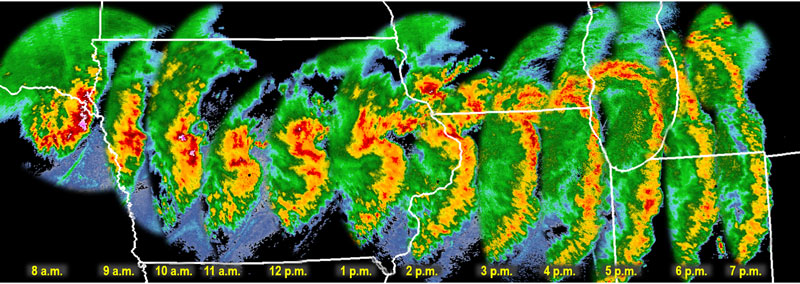
The Aug. 10, 2020, derecho on the National Weather Service radar.
The NWS received more than 700 reports of winds in excess of 58 mph, and it has estimated sustained winds were close to 130 mph. The weather service says the storm spawned 20 tornados, and described it as a “high end, once-a-decade type event for the area.”
While meteorologists have referred to the storm as a rare derecho, some locals have taken to calling it a “land hurricane.” That classification has gotten some pushback, as the storm wasn’t accompanied by the torrential rainfall characteristic of a hurricane, yet it packed a similar punch: On the Saffir-Simpson Hurricane Wind Scale, winds of 111 to 129 mph would register as a Category 3 hurricane; on the Fujita Scale, that’s the equivalent of an EF1 or EF2 tornado.
The derecho is expected to become at least the 12th $1 billion weather event so far this year in the U.S. (damages along the East Coast from Hurricane/Tropical Storm Isaias, which at its peak was a Category 1 hurricane, are expected to tally in excess of $4.2 billion).
Iowa seems to have borne the brunt of the storm. Gov. Kim Reynolds says initial estimates show more than 10 million acres of Iowa cropland were impacted; 43% of the state’s corn and soybean crop has been damaged or destroyed. Photos of the destruction — flattened cornfields, grain silos crushed like tin cans — are stark, and the storm’s path is even visible in satellite images.
“It’s an eerie feeling,” Eichhorn says. “I was driving around the countryside Sunday, and I don’t know how to comprehend what happened. When you realize how valuable agriculture is to the Midwest, and you see that much damage, you wonder what farmers, what families can do, to overcome that. I don’t know the right word to make sense of it. It’s just ... eerie.”
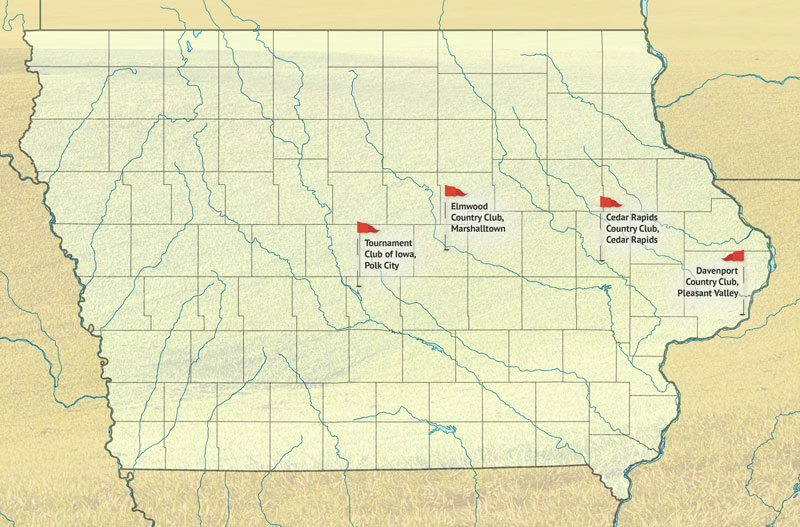
Locations of the Iowa golf courses in the derecho’s path that are profiled below.
At least dozens of golf courses lay in that swath as well, and shared in the devastation. Who was affected?
“The better question may be, ‘Who wasn’t affected?’” says Randy Robinson, executive director of the Iowa GCSA. “There have been so many that have been devastated in some way or another.”
The Iowa chapter has “basically been there for any needs the members might have,” Robinson says. It has pointed members to GCSAA’s Disaster Relief Fund, sent out communications for members, helped organize volunteers, and put out calls on social media for the golfing public to lend a hand.
“Everybody is in the same boat,” Eichhorn says. “The superintendent community is tight. We’ll all band together and help each other out. We always do.”
Below are accounts of the storm from four golf course superintendents, told in chronological order (from west to east), from the first inkling of trouble to the immediate aftermath to the longer-term toll.
Jon Hungerford
Tournament Club of Iowa
Polk City, Iowa
Before leaving for work that Monday morning, Jon Hungerford, GCSAA Class A superintendent and a 15-year association member, checked the weather forecast. The outlook? A 20% chance of precipitation, expected around 5 p.m.
“I thought, ‘Great. We’ll get our aerification and topdressing done,’” Hungerford recalls.
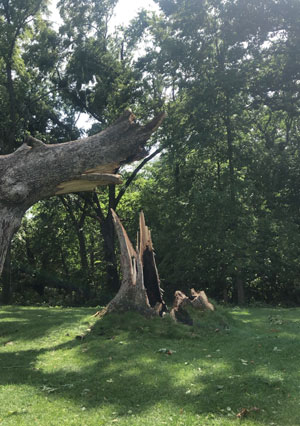
The Tournament Club of Iowa was closed that Monday for maintenance. That turned out to be a blessing.
“Luckily, we didn’t have any golfers on the course,” Hungerford says. “We only had two greens left (to aerate). We had topdressed and were getting ready to aerify. All of a sudden, it got dark. I looked at the radar. There was a thunderstorm warning, but not sirens. I got all the guys off the course and to the shop with not a minute to spare. All hell broke loose.”
Hungerford says winds reached 85 mph at the club. Near his home in Madrid, Iowa, a 14-minute drive north, they clocked in at over 100 mph.
“I’ve never seen anything like this,” Hungerford says. “I’ve seen some straight-line winds, but nothing like this. It took out 60 trees in play, most of them snapped in half. These were perfectly healthy trees. We had some that were definitely hollowed out that came down, but also big, healthy trees that were just snapped in half. That takes a lot of wind. And it wasn’t just a quick gust. This was a good 20 minutes of 80 mph.”
Hungerford says a half-inch of rain fell during the event.
“It felt like you were in a car wash,” he says. “You couldn’t see 10 feet in front of you. You couldn’t see the parking lot. It was crazy, like a hurricane storm.”
All told, Hungerford expects the 18-hole course will lose close to 200 trees, including the 60 in play.
Back in 2005, when Hungerford was a student at Iowa State University and working at Ames (Iowa) Country Club, a tornado touched down near Ames, forcing evacuation from the ISU-Colorado football game. Hungerford helped clean up Ames CC the next day, and says that damage pales in comparison to that wrought by the recent derecho.
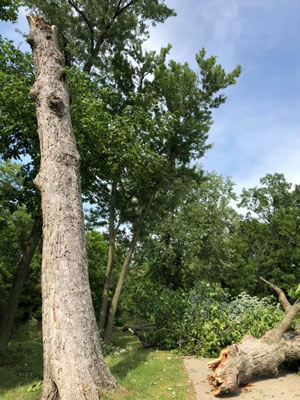
The Tournament Club of Iowa — which was without power for two days — remained closed the remainder of that Monday and all day the following Tuesday. It reopened in time for the start of the 5:30 p.m. men’s league on Wednesday, Aug. 12.
“We were working 12-, 14-hour days,” Hungerford says, “the whole crew busting our butts to get it playable and safe for league.”
Hungerford, who has been at the Tournament Club of Iowa for nine years, the past six as superintendent, says he hadn’t heard the term “derecho” before, but discovered one had hit Polk City back in 2011. He checked his notes from that year and saw a mention of damage from straight-line winds.
“We had a couple of trees down,” he says, “but nothing like this.”
Hungerford says his first priority is the safety of his crew and his golfers.
“We got everything I thought was a risk,” he says, “and started piling it in out-of-play areas. I’d guess we still have two more weeks of hauling debris and dealing with limbs hanging. We’ll definitely see some scars. But I feel pretty lucky. At first, I thought we had it bad. That night, I started talking to other superintendents and seeing videos and texts. I realized we were actually pretty lucky. A lot of courses ... I don’t think they’ll open even in the next couple of weeks. It was a big hit, even compared with all the other craziness of 2020.”
David Eichhorn
Elmwood Country Club
Marshalltown, Iowa
Just the week before the derecho rolled in, Elmwood Country Club — about an hour’s drive northeast of Polk City — had instituted Maintenance Mondays, the practice of keeping the club closed until midday so the staff could have unfettered access to tackle its maintenance tasks. On the morning of the derecho, David Eichhorn — Elmwood’s superintendent since February and a seven-year GCSAA member — and his crew were mowing in preparation for the upcoming member-guest tournament.
Around 10:30 a.m., Eichhorn got a call from his general manager in nearby Ames, Iowa. The GM warned a storm was brewing, and he and Eichhorn joked about it. The area was in a two-month-plus dry spell — of course it would rain the week of the member-guest. Eichhorn told his crew to return to the shop.
“I heard there were some high winds,” he recalls, “so I told them to get the chain saws ready.”
A few minutes later, the course’s golf pro called with another warning, and Eichhorn, sensing the storm was more severe, told his crew to head home. He and the pro stood on the veranda overlooking the course and watched the storm arrive a little after 11.
“I saw a couple of chairs start moving,” Eichhorn says. “All of a sudden, all the furniture moved to one side. I thought it was time to go inside.”
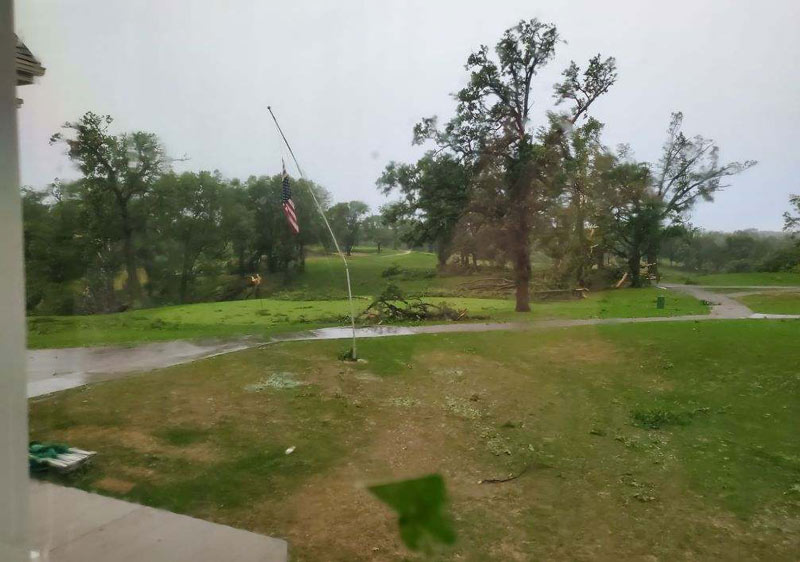
Eichhorn says winds gusted as high as 112 mph, with sustained winds over 100 mph for 40 minutes.
“I grew up in southern Iowa. I’ve seen some smaller tornadoes, and I’ve seen some straight-line winds living in the Midwest,” he says. “I was in Arizona for six years, and they have what they call a ‘haboob,’ which is a big dust storm. They have high winds, but only 30 to 40 mph — nothing like this. I’ve never seen anything like this — nothing that sustained, that prolonged. The way it kept building ... it’s like nothing I’ve ever been around.”
Eichhorn says the clubhouse lost power about five minutes into the storm. As of this Tuesday afternoon, it was still dark. The power company predicted power would be restored by late Wednesday evening. The original prediction was last Friday.
After the storm had passed, dropping about 1½ inches of rain (“I don’t know how the rain gauge managed to measure that,” Eichhorn says. “It was blowing sideways.”), Eichhorn and his pro toured the course for an initial assessment. He estimates the course will lose 400 or so trees, many of them oaks that stood 60 to 100 feet tall.
“And we’re being a little conservative with that number,” he says. “We’re trying to save as many of the big oaks as we can. It’s really hard to put in perspective. We had scheduled a big tree-removal program before this, but this is a little more than we bargained for. We lost a lot of stately oaks and quite a few ash trees. The ash trees aren’t as big of a deal, but our golf course will be dramatically altered.”
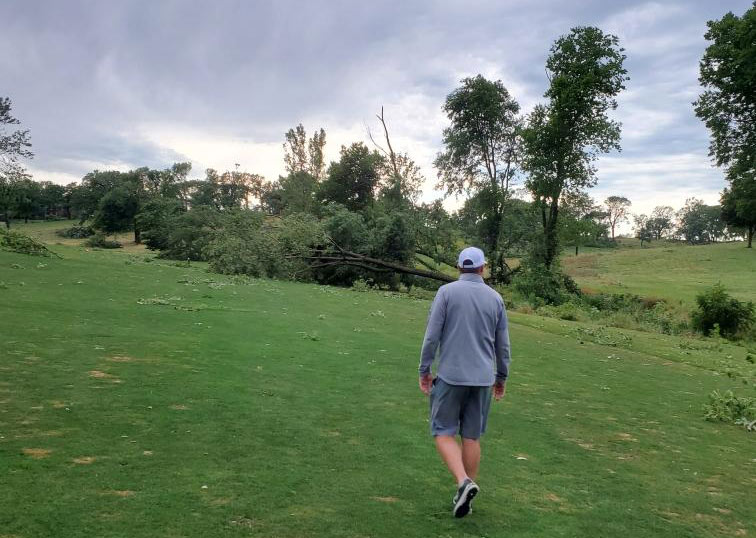
Elmwood Country Club remains closed. After that initial assessment, the staff focused on cleaning up greens and tees the first day and fairways on day two, then started cutting back fallen trees to the brush line. Eichhorn is struggling to find spots to “strategically place” the growing piles of detritus. He says the course will be able to get a permit to burn inside city limits, but a current burn ban is projected to last until late October.
“We have so much debris,” he says, “a chipper isn’t even feasible.”
Eichhorn says several members have volunteered to help, but, “There are so many widow-makers in the trees, it’s not safe to have a lot of people out there,” he says. “We do have one member, a farmer, who has some big equipment, and he’s helping move debris. Our pro has stepped in. Our general manager is stepping in. But we can’t have a huge number of people until I feel it’s safer. The membership is eager to get out and help. There will be a lot of fine detail, lots of sticks on the ground and mulching and raking, that type of stuff, they’ll be able to take care of eventually.”
Eichhorn has hired a tree service from Madison, Wis., to supplement his crew. Those four workers arrived this past Sunday, and the goal is to have the front nine open two weeks from their arrival. He estimates a full month will pass before the whole course is open again.
“Financially, it’s devastating,” Eichhorn says. “Due to COVID and everything that transpired this year, all of our big outings have been pushed back to fall. Our member-guest, another large outing, the Quakerdale Pro-Am, another big outing, all were pushed back. Two of those are definitely out. We’re hoping to keep one of those. Those are our big revenue-makers. It’s just one of those years it seems like it just wasn’t meant to happen.”
In addition to the tree carnage, Eichhorn says there was damage to a few greens on the back nine. The course also lost a gazebo and suffered shingle and roof damage to several buildings.
And yet, Eichhorn considers himself fortunate.
“Overall, we were fairly lucky,” he says. “I can’t imagine if anyone had been out on the course. I sent the guys to the shop, then sent them home. We have an area where the five guys park their cars. If we didn’t have advance notice ... we lost a giant oak tree right next to the maintenance shop; it would have landed right on top of their cars. Luckily, we had enough of a heads-up, they were all out of here.”
Tom Feller, CGCS
Cedar Rapids Country Club
Cedar Rapids, Iowa
An outing was underway at Cedar Rapids Country Club as the derecho grew. And grew.
“I knew it was building,” says Tom Feller, CGCS, general manager and director of the club. “I had been watching radar all afternoon. I saw it go through Ames, moving east. I could see the bow echo on the storm, and the cell just kept getting wider and wider.”
The 18-hole course was cleared, and folks made it to their cars and out of the parking lot before the storm hit.
“There was a small percentage for storms that day, so I was paying quite a bit of attention to the weather,” says Feller, a 21-year GCSAA member. “As far as a warning is concerned, we blew the siren on the golf course 30 minutes, 20 minutes before we suspended play. The city blew theirs five minutes after that. Ten minutes after that, it came in, and it came in with a vengeance.”
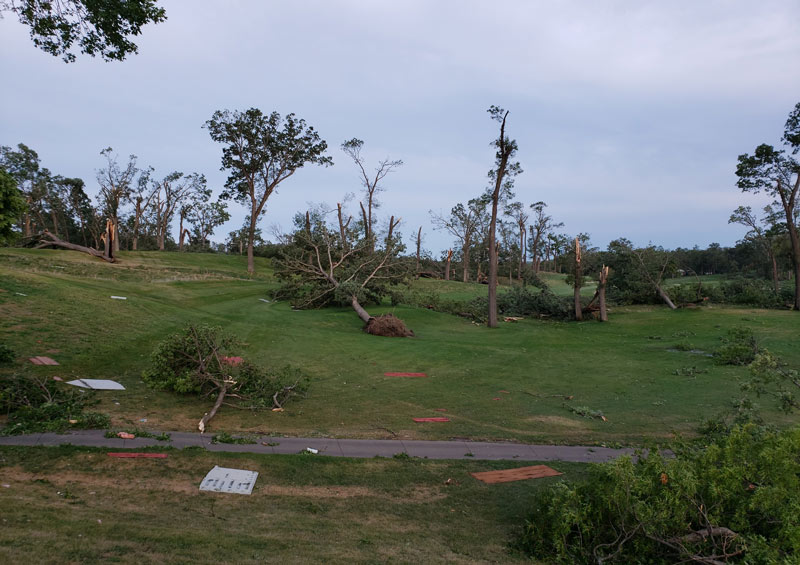
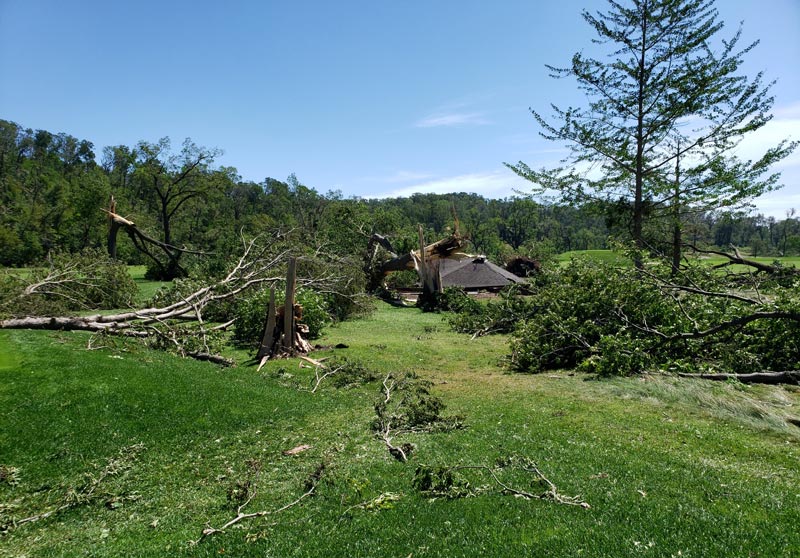
Feller says he was amazed by the duration of the storm locally — 40 minutes of sustained winds at his place — and across the state.
“I was in Myrtle Beach (S.C.) in 1989 for Hurricane Hugo,” Feller says. “It felt like this, other than all the rain we got with Hugo. It seemed like the winds were as strong. The damage to the golf course was, with the amount of trees we have, worse than Hugo.”
Feller says the derecho claimed 800 trees at Cedar Rapids CC.
“They were all old, mature trees,” he says. “We don’t have anything under 60 years old — old oaks, sycamores. We did have some damage to the clubhouse and tennis courts. The whole facility had some damage. Some of the debris did hit the greens, but it’s minimal.”
The course lost power, which was restored four days later. The cleanup is ongoing. Feller has hired an outside crew to supplement his own, and says he expects the course to stay closed another two weeks. He hopes the clubhouse will open sometime next week.
“It’s just something you have to deal with as a superintendent,” Feller says. “We did have to close the entire facility. It’s just unsafe to be around the facility until we get the tree work finished.
“It’s a big hit. It’s been a tough year with COVID. Now we’re going through this. It’s tough to be closed five weeks in prime-time season. Thank God we’re a private club with a great membership. Members are eager to help out any way they can. It’s just unbelievable. You just have to step back and take it in. Monday night was a tough night. Tuesday we came back to work and put a game plan together.”
Buoyed by visits from volunteers from golf courses and vendors across the state, Feller is spinning the catastrophe into a positive. He and his staff are taking advantage of the closure to carry out cultural practices they normally couldn’t in peak season, such as aerification.
“Now it’s about putting it all back together,” Feller says, “and it’s also an opportunity for us to improve some things we haven’t done in the past.”
Dean Sparks
Davenport Country Club
Pleasant Valley, Iowa
By the time the derecho was barreling down on the Davenport, Iowa, suburb of Pleasant Valley, it was no longer a surprise.
Dean Sparks, GCSAA Class A superintendent and director of agronomy at Davenport Country Club, says he had more than an hour’s notice. The timing, however, was still brutal. After being forced to cancel all other outings for 2020 because of the coronavirus pandemic, the course had chosen to go ahead with the Genesis Pro-Am Challenge, a fundraiser for the Genesis Nursing Scholarship Program and health programs and services in the community.
That event, held at Davenport CC and across the Mississippi River at TPC Deere Run in Silvis, Ill., was set for that Monday, Aug. 10. Organizers had scheduled tee times, starting at 11 a.m. — rather than the usual shotgun start — to allow for social distancing. Sparks was at his golf course-side home at noon, keeping a close eye on the storm. Local news stations were forecasting it would hit the Quad Cities around 1:30 p.m. Well before then, the order was given to clear the golf course, and the pro-am was called off.
Sparks watched from his garage.
“It hit about 1:15,” says the 19-year GCSAA member. “The weird thing was, I was watching the radar. The red part came through, and we got about a half-inch of rain. The red part didn’t have lightning like there normally is. Once the red part passed, I was in the driveway, thinking, ‘That wasn’t that bad.’ Then the wind came.”
After the front had passed, Sparks says winds gusted to 20 mph. Before long, they were howling over 100 mph, sustained for 30 to 40 minutes.
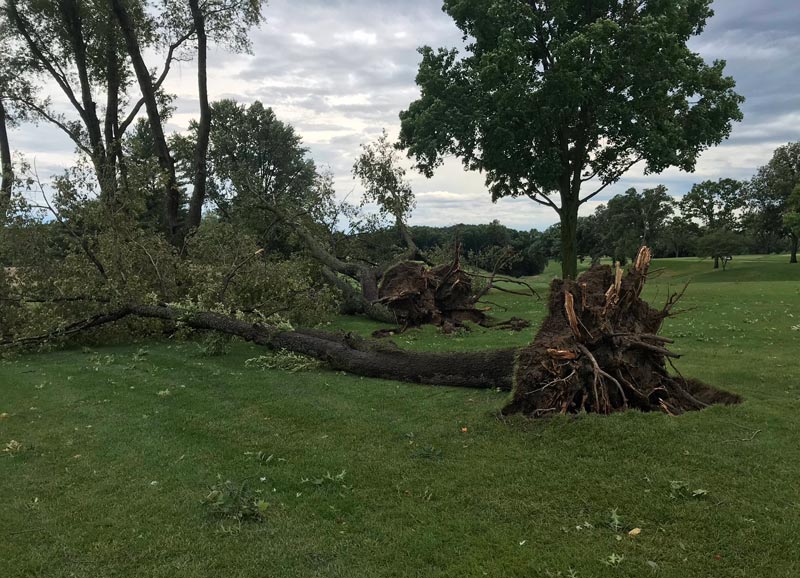
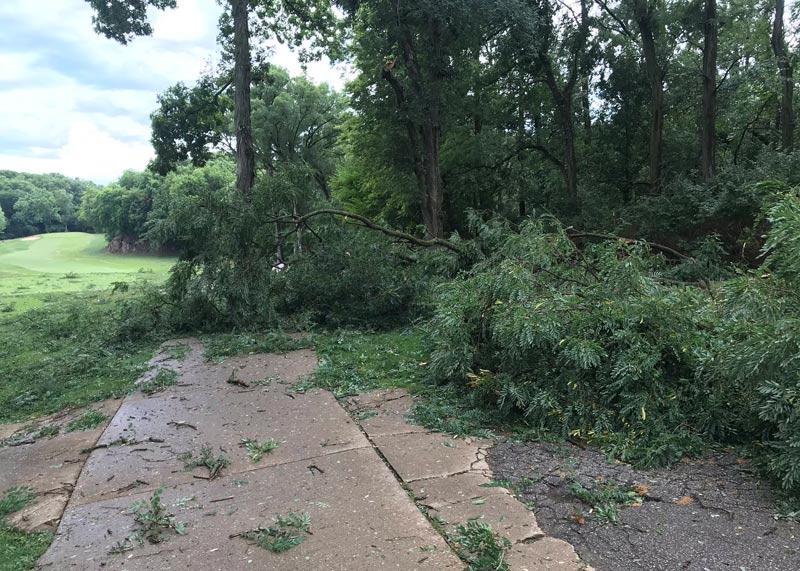
“It was unlike anything I’ve seen,” he recalls. “They’re describing it as an inland hurricane. I haven’t seen an actual funnel cloud, but I’ve seen heavy thunderstorms. We’ve had microbursts come through. I’ve been in Florida for a couple of tropical storms. This was similar. But I’ve never seen something this widespread. It’s basically all of eastern Iowa.”
Sparks estimates the 18-hole course suffered 50 to 80 downed trees. Like his more western brethren, he counts himself fortunate.
“We’re lucky. We’ve done a lot of tree work over the last few years, so we took out a lot of trees around greens, tees and fairways,” he says, “so there was nothing that was really damaged. The biggest thing was we had debris down everywhere.”
Because Davenport CC was prepped for prime playing season in general and for the pro-am in particular, cleanup was made somewhat easier.
“The thing for us that made this unique was, we were dry anyway,” Sparks says. “We were keeping conditions fast and firm. With only a half-inch of rain, that wasn’t enough to get us wet. We were able to drive around the golf course almost immediately. If we had gotten 2 or 3 inches, we would have had to wait.”
Davenport Country Club did lose power. It was restored after a week. The course was closed to golf for just one day, however.
“We did lose all revenue from the restaurant, pool and clubhouse,” Sparks says. “We lost a lot of business. But we didn’t get what places like Cedar Rapids got — not near the destruction. What I’m hearing about the Quad Cities region, everybody here is about the same. Some of them had more tree damage. Not everybody has the resources to take down their ash trees. Of course, emerald ash borers are going crazy up here. We had already taken down all 400 ash trees. A lot of municipal courses didn’t have that opportunity. ... A lot of places got hit a lot harder than we did.”
Andrew Hartsock is GCM’s managing editor.